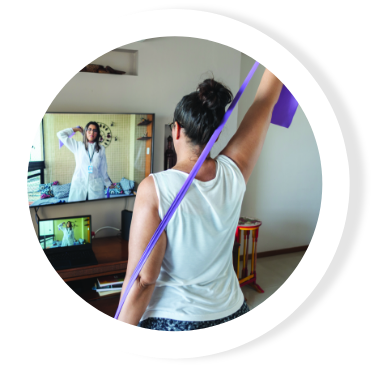Telerehabilitation in
Hemophilia Care
By Stacey Cave and Lawren De Marchi
December 2023
What is telerehabilitation?
Since the pandemic, practitioners have had to be creative in delivery, while still upholding practice standards and providing optimal care. As physical therapists, we are commonly asked, “How can you assess and treat people if you don’t see them in person?” This is where virtual care comes in.
Telerehabilitation refers to the delivery of rehabilitation via a variety of technologies and encompasses a range of rehabilitation services that include evaluation, assessment, monitoring, prevention, intervention, supervision, education, consultation, and coaching.
Providing physiotherapy virtually can help ensure patients get the care they need, especially in bleeding disorder care where patients may be located far from their hemophilia treatment center (HTC). For people with hemophilia, time associated with travelling to treatment centers, transportation costs, and inconvenient clinic hours represent significant barriers to effective management of their condition.
How is telerehabilitation delivered?
Telerehabilitation can be delivered in a variety of ways:
 Telephone
Telephone
 Text messaging
Text messaging
 Email
Email

(e.g., Zoom for Healthcare, Doxy)
Many hemophilia treatment centers (HTCs) will have questionnaires that they send prior to appointments to ensure they are aware of a patient’s needs ahead of time. Some HTCs have digital portals that patients can access from their phone or computers to complete these questionnaires. Sometimes, they can be delivered by email or text message. This kind of process can be helpful to ensure appointments are addressing all questions and concerns patients might have surrounding their bleeding disorder.
There are also questionnaires that can be sent to evaluate the care provided. An example of this would be the Telehealth Usability Questionnaire (TUQ) that helps evaluate the usability of telehealth implementation and services.
Work with your HTC to determine which method best fits your needs.
The pros and cons of telerehabilitation
As with any method of care, there are both pros and cons with this form of treatment.
PROS
- Accessibility – Patients are able to attend their appointments or communicate with their care center from wherever they need to be (e.g., office at work, lunch room at school, kitchen table at home).
- Adherence – Allows for more frequent interaction with the care team which can increase adherence to rehabilitation and recovery.
- Cost savings – Often times, HTCs are located within busy city centers which involves high parking rates, as well as travelling a distance via vehicle or transit. Telerehabilitation provides patients with a more affordable option by reducing these financial implications.
Overall, reduces burden on patients and practitioners in a variety of ways.
CONS
- Hands on care – Some aspects of physical assessment cannot be done by observation alone. Patients would require landmarking and palpation skills.
- Technological capabilities – There can be a bit of a learning curve when a new process is introduced, especially when it falls under the technology realm. Everyone has different levels of technological literacy. Language barriers and visual or hearing impairments can add more layers of complexity.
- Connectivity – Not everyone has access to high-speed WIFI and updated computer or phone hardware.
We’ll explore these challenges further below.
What can we address in a telerehabilitation session?
Virtual care works well in situations where self-management instruction and monitoring are the primary methods used to address the therapeutic goals.
Telerehabilitation, in general, can be especially well suited for patients with chronic disorders such as hemophilia and other related bleeding disorders that may benefit from more frequent interactions with care providers at a specialized HTC.
In hemophilia care, scenarios that may lend themselves well to virtual physiotherapy visits include but are not limited to:
- Assessment of acute joint or muscle bleeding and treatment advice
- Follow-up after a bleed
- Gait and functional assessment
- Post-bleed rehabilitation
- Post-surgical rehabilitation
- Monitoring of chronic joint issues in between clinic visits
- Advice regarding physical activity and sports
When would telerehabilitation not be appropriate?
Telerehabilitation has limitations compared to an in-person encounter, such as the inability to perform hands-on examination, assessment, and treatment. For this reason, in-person visits are necessary in some circumstances when the hands-on assessment is more critical for clinical decision-making, performing standardized outcome measures or in emergency situations when urgent care is required.
It is up to you and your physiotherapist to determine what is best for you, based on your particular condition and preference, available technology, and other risks and benefits.
Other ways telemedicine can be helpful
In addition to the delivery of clinical services, telemedicine or virtual care can be used for teleconsultation, teleeducation, and teleresearch.
Can involve acute and chronic clinical situations such as the evaluation of a current bleeding episode or the review of X-rays or laboratory results. In the setting of an acute bleeding episode, teleconsultation can facilitate early and appropriate treatment by reducing the time between bleeding onset and its assessment and management.
Allows real-time educational interactions between healthcare professionals and patients, and can facilitate discussions of diagnosis and management of bleeding disorders. Teleeducation can also facilitate information sharing with respect to clotting factor storage and administration, home infusions, and treatment guidelines.
Allows patients who live in remote areas can participate in clinical trials and registries. To date, however, most telemedicine research has been focused on evaluation of its impact on health outcomes, cost effectiveness, and patient and family satisfaction.
Tips to optimize a virtual session
-
Prepare your environment.
- Private room with minimal distractions
- Consider location for best WIFI or phone connection
- Give yourself plenty of space to move around
- Ideally, use a laptop/desktop with a webcam and microphone if you have one; that will give you the best view of exercises and other content. However, a tablet or phone will also work.
- Test your technology ahead of time to make sure everything works correctly.
- Use headphones for better audio quality, if needed.
- Dress appropriately for proper visualization of body areas (e.g., wear shorts for lower extremity assessment).
- Make a list of objectives you would like to address during the session and any questions you want to ask your healthcare provider.
- Have a pen and paper handy to make notes if needed. You can also ask your provider to send you a summary of your visit and any instructions or recommendations after the visit so you can easily remember what was discussed.

Conclusion
Virtual care isn’t going anywhere! When used appropriately, telerehabilitation can be a beneficial and important component of comprehensive hemophilia care.
We hope this information has increased your knowledge of telerehabilitation and how it may be incorporated safely and effectively into your hemophilia care plan.
Please reach out to your HTC physiotherapist to find out more about how telerehabilitation could work for you.


